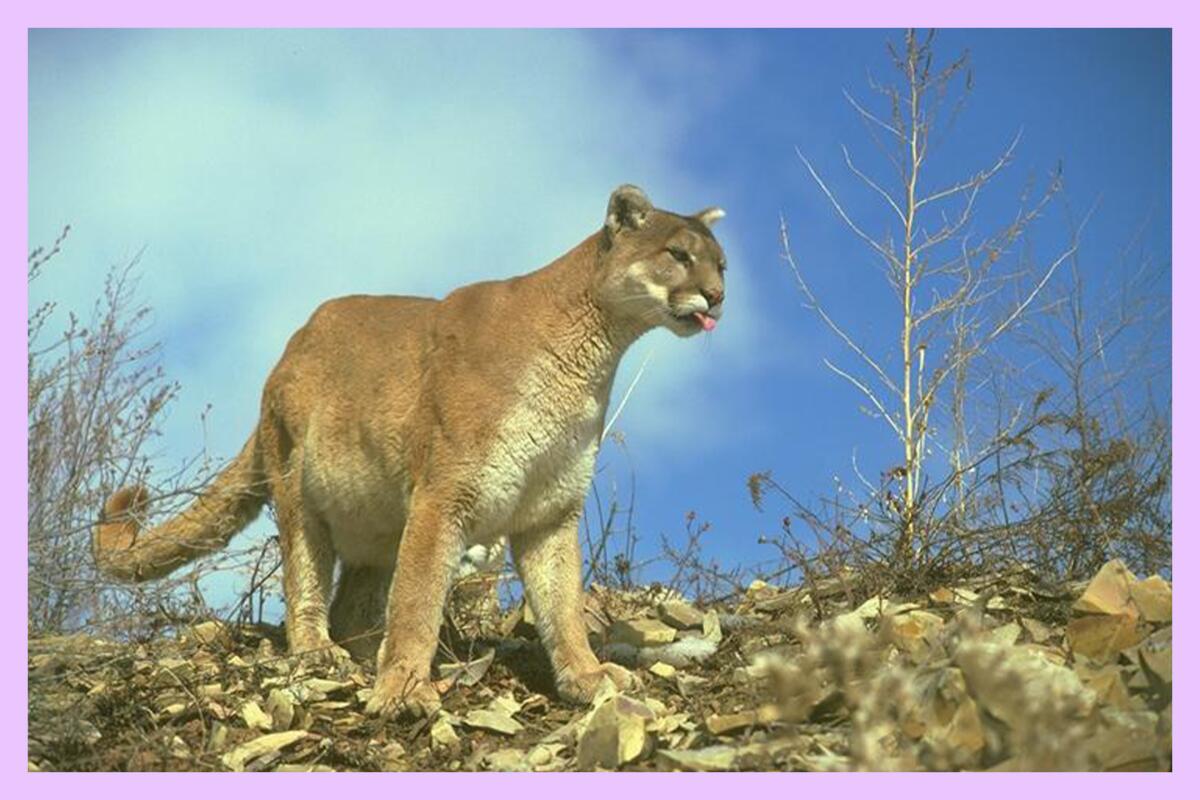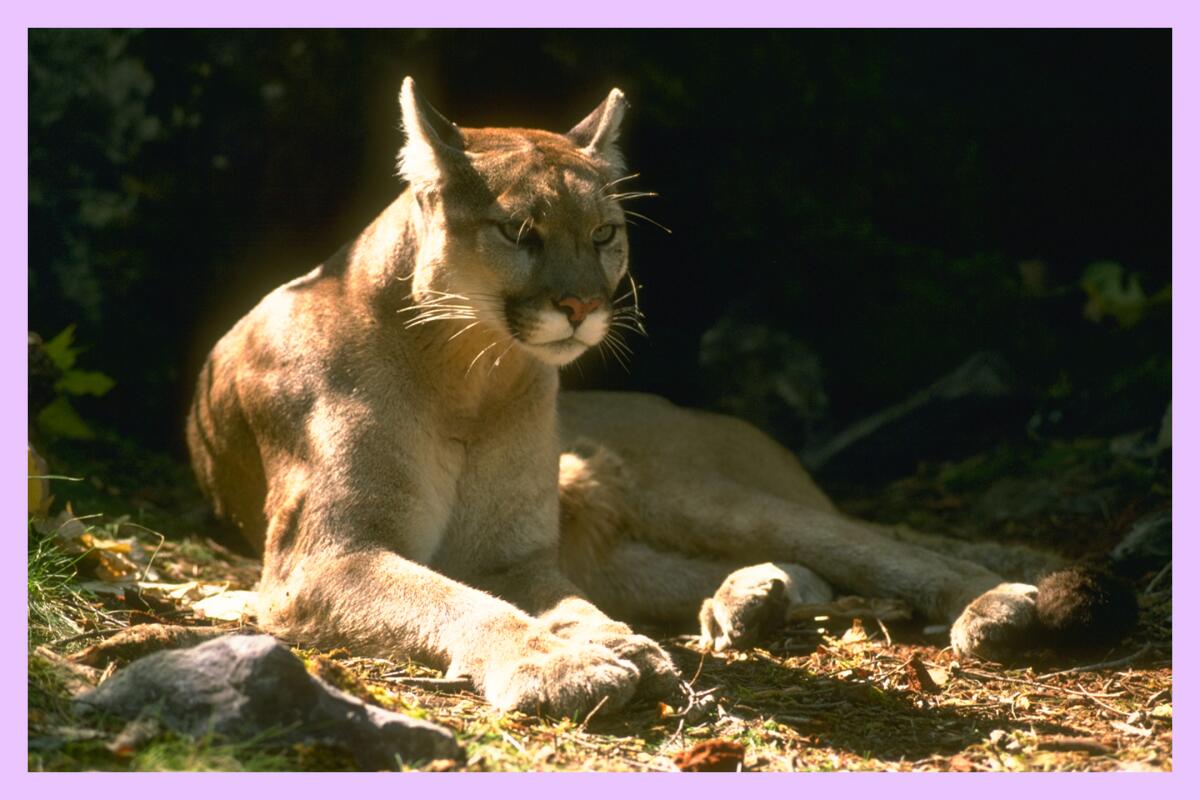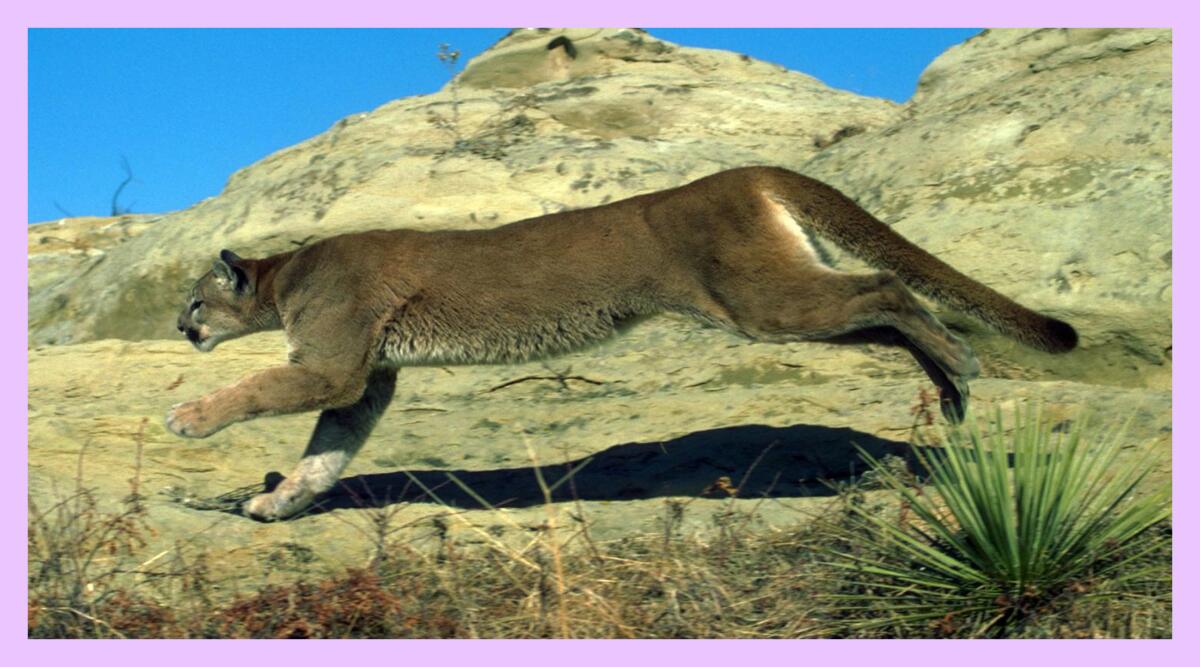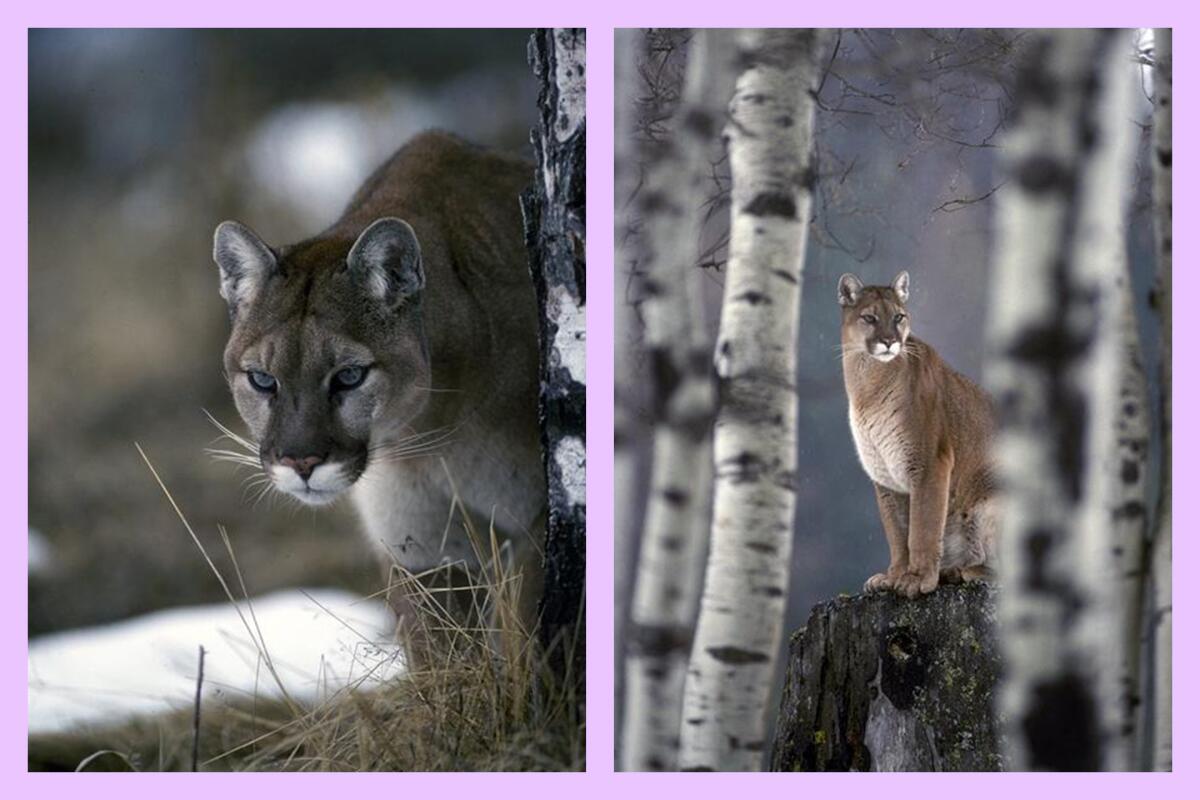I was around 16, sitting on the front porch talking to my friend on the phone, as many millennial teens did, when I heard a loud screech erupt from the pasture behind my childhood home in Oklahoma.
I had a split-second flashback to years earlier, during a camping trip, when my Girl Scout leader described the sound a mountain lion makes. “It sounds exactly like a woman screaming,” she said. We didn’t believe her. How could that be so? We’d seen “The Lion King.” We knew lions roared.

A mountain lion bares its teeth and folds its ears.
(California Department of Fish and Wildlife)
I immediately hung up the phone and dashed inside to tell my dad there was a mountain lion nearby. We needed to check on the cattle.
Newsletter
You are reading The Wild newsletter
Sign up to get expert tips on the best of Southern California’s beaches, trails, parks, deserts, forests and mountains in your inbox every Thursday
You may occasionally receive promotional content from the Los Angeles Times.
Through my teen years, my family’s land remained in that lion’s territory. My cousin saw it from a tree stand while deer hunting on our land. Workers from a natural gas company saw it while checking well sites. I heard it twice.
Given those encounters, I felt a little jumpy when I started hiking in L.A. I knew it was extremely rare to see a mountain lion while out hiking, but having heard one in person, it didn’t feel rare.
As experts like Robert Martinez (L.A.’s unofficial mountain lion man) point out, my experience falls far outside that of the average SoCal hiker.
For the last 12 years, Martinez has documented mountain lions, bears and other local wildlife using more than 20 trail cameras that he sets up, thanks to a permit, in Angeles National Forest. What started as Martinez simply wanting to see a lion has turned into what is essentially a research project that helps forest officials and wildlife advocates better understand the catamount population. (To learn about the lions that live in the Santa Monica Mountains, visit this page.)
When it came time to research ways Wilders can stay safe if they see a mountain lion on the trail, he was the first person I called.

Mountain lions are rarely seen on the trails in part because there are estimated to be only between 3,200 and 4,500 lions in California.
(California Department of Fish and Wildlife)
Even though Martinez admits he’d love to see them more often, he emphasized how rare it is to see a lion in person. He has been in the woods hundreds of times and is actively looking for lion tracks and scrapes — the territorial marks they leave, similar to the long marks your house cat makes in their litter box — and still has only seen lions three times. They all wanted to get far, far away from him.
The first time, he was walking at night with a flashlight on a trail he’d visited numerous times.
“Within the first seven to nine minutes, I’m walking, and I see these big yellow eyes” near the end of a long footbridge, he said.
He moved his flashlight past its face and caught a glimpse. “I lost my mind at that moment,” he said. “I was like, ‘Oh my God!’” The lion, about 100 feet away, turned around and left.
Along with learning how to respond if you do encounter a ghost cat, I hope you’ll glean from below a better understanding of how important it is that we continue to conserve the lands where these big cats live. It’s for everyone’s safety, including the lions’.

Mountain lions are known by many names, including ghost cat, cougar and catamount.
(California Department of Fish and Wildlife)
1. Stay calm and be big
If you do see a cougar on the trail, the first step is to remain calm. Do not run. Do not turn your back.
You should never play dead in front of a cat, the Sacramento-based Mountain Lion Foundation advises. Instead you should maintain eye contact and do everything you can to look bigger: stand up straight, open your coat and raise your arms. Wave your arms slowly and speak in a firm, loud tone. If necessary, throw items at the lion. But not before giving the cat the space and time to walk away.
2. If you have a small child or dog with you, pick them up
Preferably you would do this without bending over. And if you can, put them on your shoulders to help you appear even bigger.
If hiking with a dog, pull your dog as close to you as you can. Pick it up if it’s small, but be mindful how you do this because “you don’t want to bend down so low you now don’t look like an adult human,” said Tim Daly, a public information officer at the California Department of Fish and Wildlife.

Hikes in known mountain lion territory may include signs like these.
(California Department of Fish and Wildlife)
3. Make a lot of noise
When it comes to encounters with bears, experts say simply letting the bear know you’re there might be enough, and that you shouldn’t startle it. But with mountain lions, you really do want to be quite loud. And extra points for creativity.
One 9-year-old boy frightened a mountain lion away by playing his trumpet, according to the Mountain Lion Foundation.
“Make sounds that aren’t natural at all,” Martinez said. “If you’ve got metal pans and a spoon, bang it really hard. Whatever you’ve got that can be the most obnoxious, loud, piercing sound I think will help you because they’re not used to hearing those kinds of things on a day-to-day basis, so that might make them go: ‘What the hell is that?’ and get out of there,” Martinez said.
Then watch how it reacts, slowly backing away, “and hope that lion has better things to do than worry about you,” Daly said.

After an encounter with a mountain lion, leave the area immediately.
(California Department of Fish and Wildlife)
4. Get out of there
Daly said even if the lion leaves, it’s probably best to leave the area yourself and then report the sighting to a nearby ranger and on the state’s wildlife incident reporting system, which researchers check frequently.
Mountain lion attacks on humans are rare, but they do happen. Since 1890, there have been fewer than 50 verified mountain lion attacks on humans in California, including six fatal incidents, according to the California Department of Fish and Wildlife. In most cases, the person was alone when they were attacked.
Of the documented attacks, just over a dozen have been on children. This is why wildlife officials stress the importance of keeping children close while out hiking.
That is hard to hear. I do draw comfort, though, in the fact that millions of people visit our mountains every year, and attacks, especially fatal ones, from any animal remain rare.

Since 1890, there have been fewer than 50 verified mountain lion attacks on humans in California.
(California Department of Fish and Wildlife)
The experts I spoke to stressed that, if you’ve hiked in Southern California, you’ve likely hiked past a mountain lion. But we rarely see them in part because there just aren’t that many lions in California. It is estimated that we have only between 3,200 and 4,500 lions in the entire state (compared to the estimated 65,405 black bears here).
“No lion is raised to hunt humans. There’s no mom lion out there, telling them, ‘Oh, when times are thin, you know, we will get that guy right there or that hiker,” Martinez said. “Lions aren’t looking for people at all.”
Often, he said, when a lion does attack, the data show one reason is because humans were encroaching on their shrinking habitat, further underscoring how important it is to protect our wildlands.

3 things to do

Take a field trip and see Joshua trees.
(Irfan Khan / Los Angeles Times)
1. Take a desert field trip to Joshua Tree
Join the Mojave Desert Land Trust on Nov. 2 for a field trip co-hosted by environmentalist Isaias Hernandez (known online as Queer Brown Vegan) for a deep dive into desert ecology. You can either leave with the group on a bus from Union Station or drive yourself, meeting at the land trust’s headquarters in Joshua Tree (the community, not the park). The trip will include a guided tour of the land trust’s seed bank and native plant garden. The group will also hike 2.3 miles with biologists to learn about endangered desert wildlife. Most of the land trust’s facilities are wheelchair accessible, but the hike is not considered as such. Organizers will provide snacks and a light lunch, but participants can also bring their own lunch and water bottle. The group will arrive back to Union Station about 6 p.m. Bus tickets are $50, or $30 for young professionals and students. It is also $30 to attend the event if you drive yourself. Space is limited. Tickets are available at eventbrite.com.
2. Learn (more) about cougars at Eaton Canyon
The Eaton Canyon Nature Center and Cougar Conservancy will host a free community training Saturday on how to coexist with mountain lions in local communities and mountains. The day’s programming will be split into two parts. From 10 a.m. to noon at the center (1750 N. Altadena Dr.), guests of all ages can visit educational tables and participate in fun co-existence-themed activities. From noon to 1:30 p.m., guests 16 and older will gather in the Eaton Canyon Nature Auditorium for the conservancy’s training, which will go over safety tips for recreationists, including on bear spray and air horns. No prior experience is required. Register at eventbrite.com.
3. Hike with docents at the Valley View Preserve near Ojai
Docents from the Ojai Valley Land Conservancy will host a 2.5-mile, moderately strenuous hike at 8:30 a.m. Sunday through the Valley View Preserve. The hike will start at the top of Foothill Road and traverse the preserve’s upper trails. Participants will explore several sections of different trails on this preserve with experienced guides. The hike will include great views of the Ojai Valley. Organizers request that hikers be 12 and older, and that no dogs attend. Hikers should wear pants and closed-toe shoes or boots. Attendees should bring sun protection, water and snacks. Hiking poles are recommended. Space is limited. To RSVP, email Claire Woolson at [email protected], specifying which hike you’d like to attend and how many people are in your party. Learn more at ovlc.org.

The must-read

A Mountain High ski resort crew works on a chairlift recently.
(Michael Blackshire / Los Angeles Times)
When the Bridge fire erupted in early September and charged toward Wrightwood, I joined hundreds of people watching the fire on Mountain High Resort’s live cameras, whose usual purpose is to allow skiers and boarders to check slope conditions. I expected to see a much worse picture, but as Times writer Noah Haggerty reports, dozens of dogged workers helped saved Mt. High by placing several of its snowmaking guns around the resort’s perimeter. General manager Ben Smith directed the operation while ensuring campers were evacuated and staff left in time. Smith was the last employee to leave, and although he knew they’d done everything they could to save Mt. High, he wasn’t optimistic. “When I left out of here … I expected to come back to everything gone,” he said. But much of the resort survived. Mt. High expects to open by Thanksgiving. “Come wintertime — when the snow comes — you won’t even know there was a fire here,” said Damaris Cand, guest services manager.
I hope so. I think it’s time I finally learned how to ski!
Happy adventuring,

P.S.
One question on many L.A. hikers’ minds as we draw closer to winter is, when is it going to start raining? Every year, I try to keep up with what meteorologists are forecasting for winter so I can better plan out my hikes. If it’s expected to be a wet winter, I try to hike mountains at higher elevations earlier in autumn. But this winter’s forecast remains TBD. As The Times recently reported, Southern California is expected to see a weak La Niña, but it remains unclear how that will affect precipitation. Until it snows, you can find me hopefully somewhat high above the clouds!
For more insider tips on Southern California’s beaches, trails and parks, check out past editions of The Wild. And to view this newsletter in your browser, click here.
